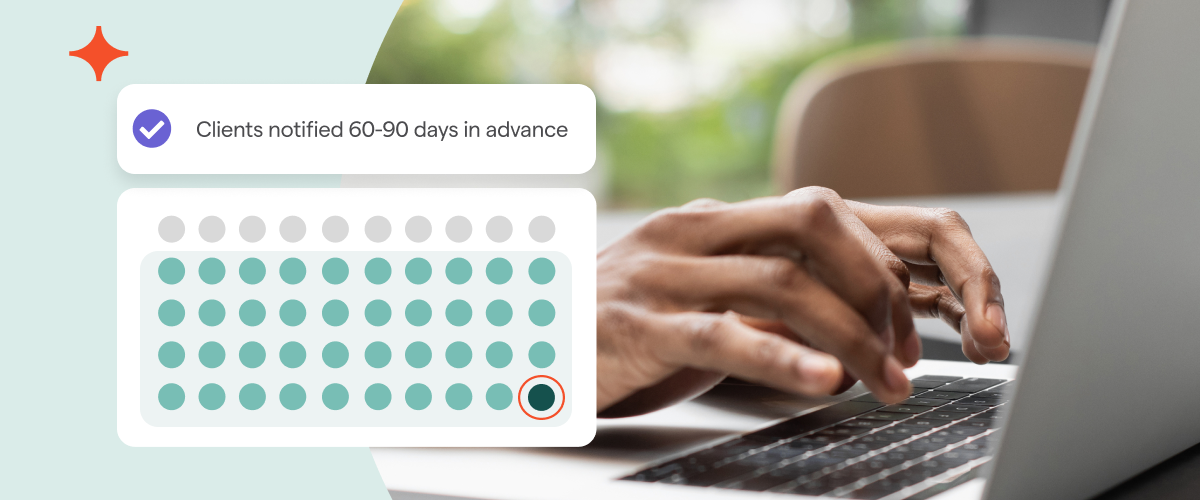How to communicate a price increase to your clients (without feeling awkward)

This article has been modified for different regions, click here to access the AU version or the US version.
If you've been thinking about raising your prices, you are most certainly not alone. The current economic climate globally has many businesses – including accounting firms – grappling with the rising cost of products and service, and considering increasing their rates.
According to a survey by CNBC, 75% of small businesses in the United States are experiencing rising costs in supplies, and 40% are planning to raise their prices. Meanwhile, research by the British Chambers of Commerce found that almost two-thirds of UK firms are expected to raise their prices in 2022. A similar trend can be seen in Australia. According to the Australian Bureau of Statistics (ABS), as of March 2022, 39% of all businesses expect to increase their rates.
If you can relate to these statistics, then you know that planning to increase your prices is rapidly becoming a ‘must’ do, versus a ‘should’ do.
That said, the thought of increasing your rates may induce a bit of anxiety, particularly because many firms don’t want to risk losing clients. Figuring out how to raise your prices is already a challenging task. But also having to communicate that to your clients? That’s even tougher.
So, to help you navigate through the process of increasing your prices, we’ve put together a practical guide.
Deciding on your price increase
Most accountants do a tremendous job helping their clients stay on top of their books, maximise their margins and implement financial best practices, but they often neglect those same practices when operating their own business.
These days, however, you can no longer forgo tasks like reviewing your pricing and profitability. Margins have been squeezed over the past year, driven by multiple factors including higher costs of living, inflation, and oil prices. As such, you need to constantly stay on top of your costs and be prepared to raise your rates accordingly.
If this task has you worried about losing clients, it’s worth noting that you cannot deliver quality service if you’re not charging enough. If you continue to operate with less-than-optimal profit margins, the quality of work delivered by your business may suffer and you’re likely to end up losing clients anyway.
Here’s how to ensure that your prices support a healthy bottom line.
Understand your business and profitability
“The very first thing that a firm should do is to sanity check their own business,” says Carl Reader, Head of Accounting (EMEA) at Ignition. He adds that it helps to, “understand your breakeven position and determine your true profitability”.
This can be done by analyzing the costs associated with your services. Factor in the cost of:
Staff wages and ongoing costs.
Software subscriptions.
Office equipment and supplies.
Telephone and internet.
Rent and utilities.
Training and education.
Professional association fees.
Your own time and expertise.
As Joshua Lance, also Head of Accounting at Ignition puts it, “Having a good understanding of your business in general” is essential to any re-pricing initiative.
If you want to take a more granular approach, consider analysing the profitability of each service line. This way you can understand exactly how much profit (or loss) is being generated by each service that you provide your clients. After all, the time and costs associated with preparing a client’s taxes may be completely different compared to the costs of generating a profit and loss report. They have different time inputs and require team members with different skill levels to prepare and finalise.
Once you understand the costs involved in providing your services, you will be able to track how these have changed over time and will continue to. You could find that a small job that used to cost you £100 to produce might now cost £200 (ie, a 100% increase), but another job that previously cost £3,000 might now only cost £3,600 (ie, a 20% increase).
Those percentage increases may vary depending on the type of service. The insights you glean at this stage will give you a better idea of how profitable each service is, in turn helping you decide the amount and manner in which to raise your rates. It can also help you determine which services you may wish to focus on growing, and those you may wish to stop offering if they are not profitable enough.
Other factors to look at would be your churn rate and client satisfaction with your services.
“I would suggest that all firms make sure that their own house is in order,” says Carl. “They may want to make sure they aren't running at a high churn rate already and they’re giving good levels of service, and so on. Because one of the real risks [of a price increase] is if they've got a very unhappy client base, this is only going to exacerbate that situation.”
Decide what type of increase to implement
Once you know your numbers, it’s time to decide what type of increase you’ll implement. You generally have two options:
A blanket increase across all service lines.
A service-level rate increase.
The first option is pretty straightforward: you set a percentage by which to increase your prices and apply it across the board. This is ideal if there isn’t a lot of variation between the margins of different services or if your end goal is to just cover the general rising costs of doing business.
For example, if you have a lot of SMB clients and see that there isn’t a lot of variation between the costs of doing tasks such as preparing profit & loss reports, doing their bookkeeping, and so on, then you can decide on a set percentage increase and apply it to all these service lines.
However, if you find that certain services cost a lot more to deliver than others, then a service-level increase is more appropriate.
Let’s say you discover that you spend a lot more resources preparing taxes for your corporate clients versus sole proprietors. In this instance, it may make more sense to apply a larger increase to your corporate tax preparation fees, since they cost significantly more to deliver.
The right path forward is a completely internal decision, and it depends on your current profitability, your forecasts, and your business objectives.
Pro tip: Automate your price increases
Raising your prices shouldn’t be a hassle—or a tough conversation. With Ignition’s AutoPricing feature, you can increase fees across multiple clients in just a few clicks. Set it, apply it, and watch your revenue grow—without the back-and-forth.
Evaluate your pricing on an annual basis
As for how often you should increase your rates, a good rule of thumb is to do it at least annually. Another approach is to evaluate your pricing before the end of each client engagement.
"If your engagement letter covers one year, then you could use that renewal period as an opportunity to re-price your services," says Joshua.
He adds that accountants often just renew their engagements straightaway, without reevaluating their prices. So in your firm, it pays (literally) to take a moment before a client’s renewal period to rethink and re-price your offerings.
Communicating your price change notice to clients
Start by sending an email to your client base
Sixty to 90 days before raising your prices, send an email or a one-to-many communication to inform your whole client base about the change. This is an ideal time frame because it gives clients enough time to prepare for your new rates.
When you do it too close to the date of your price increase (say just a month before), some clients may feel that they’ve been caught off guard and thus react negatively.
On the other hand, if you give them ample notice, you are less likely to experience pushback from clients, because your actions display courtesy and respect.

Email templates for raising your prices
To help with this step, here are email templates that can give you a starting point for crafting your personalised communications.
If you engage your clients on a yearly basis, they should already expect a new proposal will be sent to them, and the pricing increase will be reflected in this. On the other hand, if you have ongoing engagement with your clients, it would be worth pointing out to them that they’ll receive a new proposal that includes the changes in pricing.
Fixed fee billing template
Hi [FIRST NAME] —
This is to let you know that there will be an increase of [INSERT AMOUNT] in our [INSERT SERVICE LINE] pricing. This will take effect when our current engagement ends, which means that if you decide to renew our engagement, the new agreement will reflect this pricing.
We’ve made every effort to delay and minimise our price increase. But as you may know, businesses across the country are experiencing ever-increasing costs, and our accounting firm is no exception.
This change in our pricing will enable us to continue delivering high-quality services and help ensure that your business is well taken care of.
We truly appreciate your support and we look forward to continuing to work with you.
Sincerely,
[SENDER NAME]
Monthly recurring billing template
Hi [FIRST NAME] —
After carefully reviewing our costs and services (which we also encourage you to do), we have made the decision to increase our monthly engagement pricing. Beginning [INSERT DATE], your engagement will cost [INSERT AMOUNT] per month.
Please know that we have made every effort to minimise and delay this price increase. But as you know, costs have been steadily increasing since last year. This change in our pricing will help ensure that our team has all the resources needed to serve you.
We thank you for being a valued client and we hope to continue working with you in the years to come.
Best regards,
[SENDER NAME]
Template for hourly billing
Hi [FIRST NAME] —
We wanted to let you know about changes to our hourly rates. Beginning [INSERT DATE], our new prices will be [INSERT AMOUNT].
Please know that we have done our very best to hold off on raising our rates. That said, businesses across the country have seen major increases in costs, and our firm is no exception.
This new hourly rate will allow us to continue delivering our services with the quality and care you’ve come to expect from us.
We appreciate your business and look forward to supporting you and [INSERT BUSINESS NAME] going forward.
Best regards,
[SENDER NAME]
Sending out a message like the ones above removes some of the communication burden, helping you be more efficient with relaying your pricing information.
Just bear in mind that a one-to-many message can feel impersonal, so try to take steps to personalise your message. Use a client communication platform or mail merge solution that enables you to add each client’s name and company into your messages. Include a list of their existing services that will be impacted by the change. That way, your message won’t read like an email blast.
Schedule one-on-one conversations
How to deal with the awkwardness and pushback when raising your prices
Avoid the hard sell
Don’t be shy about communicating your value to customers
Don’t be afraid to toot your own horn. In what ways have you served your clients? What have you helped them achieve? Use the answers to these questions to communicate your value to customers.
Here are some ideas:
You saved the client X hours per week.
Your firm helped increase their revenues by X%.
You found £X in tax savings.
Your firm helped their business secure COVID relief.
Be detailed about your deliverables
Use these conversations as opportunities to explain, in great detail, the tasks you do for your clients. As an accountant, you handle a myriad of jobs, including generating reports and maintaining the client's books.
Take, for example, preparing a balance sheet. While the final deliverable comes in the form of a document or spreadsheet, there’s actually a lot of work involved in creating the document. There’s the collection of information, the reconciliation of accounts, the verification of information, and making adjustments for legislation.
As the service provider, it’s essential that you allow clients to see all the work that goes into these tasks. Doing so will help convey your value and aid your re-pricing initiatives.
Anticipate objections
Any conversation becomes awkward when you’re at a loss for what to say. Fortunately, you can avoid such situations by preparing for each client encounter.
Anticipate any objections the client may raise during your call. Have a think about their top issues and concerns, then prepare your answers in advance. If you’re nervous, practice what you’ll say ahead of time or list out your talking points.
Give clients options
If there’s major pushback, it may be helpful to present your clients with alternative offerings, says Joshua.
“I like the idea of giving options when you do re-pricing, because it gives your client some agency in the process,” he says.
His recommendation is saying something along the lines of:
“Our monthly accounting price is increasing from £800 to £1,200. These are the services included in that scope. If you want to stay at £800, we can do that, but it's going to have a lesser scope.”
Doing so demonstrates flexibility and helps to give your clients wiggle room to work with you.
Incorporate re-pricing into your customer success efforts
If you’re implementing customer success initiatives (and you totally should), then having a conversation about pricing becomes a whole lot easier, says Joshua.
For instance, if you’re already in the habit of checking in with your clients and staying in touch on a regular basis, then the topic of pricing is much easier to bring up.
“I think the whole re-pricing conversation is one part of the client success or customer success process you do. If you start to build on this kind of customer success process in your firm, then these conversations aren't as awkward,” he continues.
If you find yourself having some difficulties in bringing up pricing, it will be beneficial (both for you and your clients) to make customer success a bigger focus in your firm. You can, for example, start having regular check-ins with your clients on how you can better help them succeed.
That way, when you do decide to raise your rates, the process (and the conversation) becomes easier.
Implementing your new pricing
When your new pricing takes effect, be sure to update all the places where your rates are listed. This includes your website, engagement documents, contracts, price lists, and so on.
Client engagement software like Ignition can help you do this quickly. Simply update your service library, create a brand new proposal and the software will automatically list your new prices in your engagement letters and agreements, ensuring you bill your clients accurately.
Once you get your clients on board the new pricing, have them sign the updated engagement agreement before the new prices take effect. You want to do this sooner rather than later to ensure you’re able to enforce your new pricing.
Over to you
The right solution can make re-pricing your services a whole lot easier. Ignition’s client engagement platform comes with several features to streamline the process of implementing your new pricing.
Want to see Ignition in action? Take an online tour of the software.


